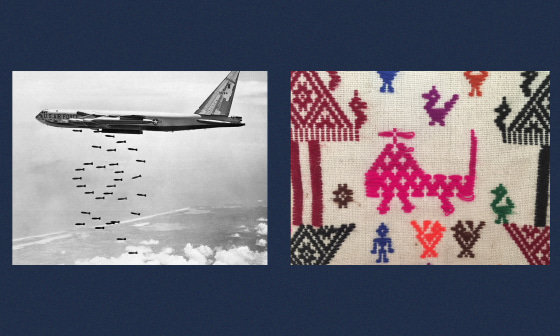For generations, the women of rural Laos have told the stories of their lives through weaving, threading symbols like flowers, rainstorms and mythical serpents into everyday clothes and fabrics.
Fifty years ago, these symbols took a thematic swerve to portray a new, violent reality: missiles, grenades and attack planes.
They were the images of America’s “secret war” in Laos, a relentless bombing campaign during the Vietnam War.
For a generation of Lao women, who grew up with looms and thread from childhood, weaving became one way to make sense of the conflict that transformed their lives and nation forever.
The war is quickly fading from memory, in both America and Laos. But half a century later, the weavings offer a haunting glimpse of how it affected women.
Monday marks 50 years since the U.S. ended its nine-year bombing of Laos (1964-73). The scale of the operations was concealed from the American public until 1970, as Laos was technically neutral in the Vietnam conflict. But Vietnamese communist forces and the CIA were waging a shadow war in Laos.
To tip the scales, the Defense Department began an air campaign of gigantic scale: the equivalent of a planeload of bombs dropped every eight minutes for nine years.
For scores of Lao villagers, almost all of them farmers with no knowledge of the outside world, life changed forever.
American planes roaring overhead, releasing bombs, rockets and defoliants like Agent Orange, became part of their everyday existence.
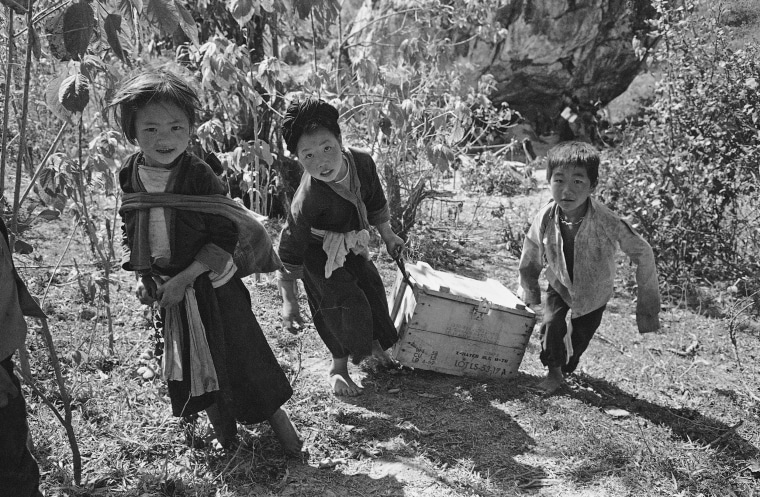
The shock and trauma are evident in what women wove.
Women were then, and remain today, “the backbone of Lao society,” said Linda McIntosh, a textile researcher in Luang Prabang, Laos.
Women not only were in charge of managing the household and raising children; they were responsible for making all the family’s clothes.
Weaving was more than a chore. It was a form of expression.
Weaving gave women an outlet to express what they were thinking, about this life and the next.
Traditional textiles blend symbols of the everyday, like rainstorms, birds and beetles, with those linked to the afterlife, like mangoes, elephants and ancestor deities.
“This is their vocabulary,” said Julia Brennan, who has visited Laos multiple times and whose company, Caring for Textiles, consults on preservation efforts around the world. “They’re not writing poetry or books or taking photographs. In the 1960s, the only channel they had was to weave stories into their own textiles.”
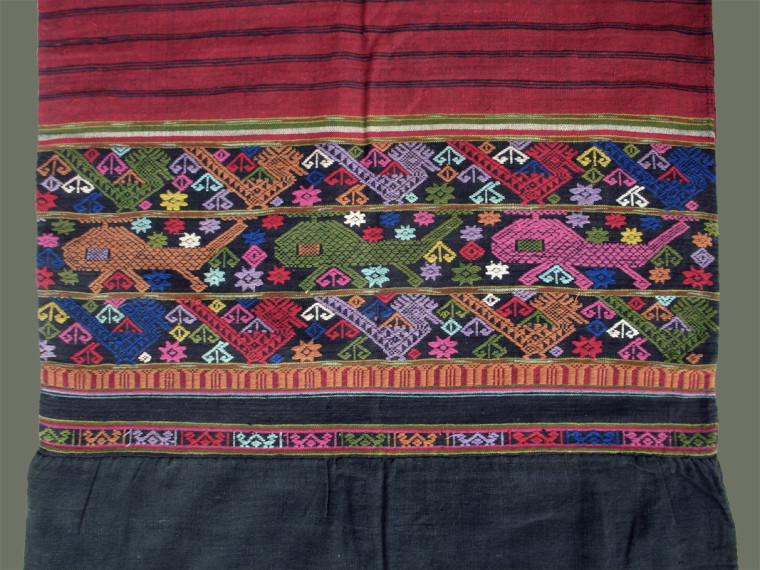
It was probably near the end of the war, McIntosh and Brennan said, that women began to incorporate martial themes: missiles, helicopters, tanks and fighter jets.
The women probably would have understood them not as state-of-the-art military technology but as powerful beings with immense power to kill and destroy, they said.
Weaving their likenesses into fabric, as with other spiritual entities, may have been an effort to ward off harm.
“It’s not just about pretty things,” McIntosh said. “Textiles are powerful. You put deities, you put gods, because they protect you.”
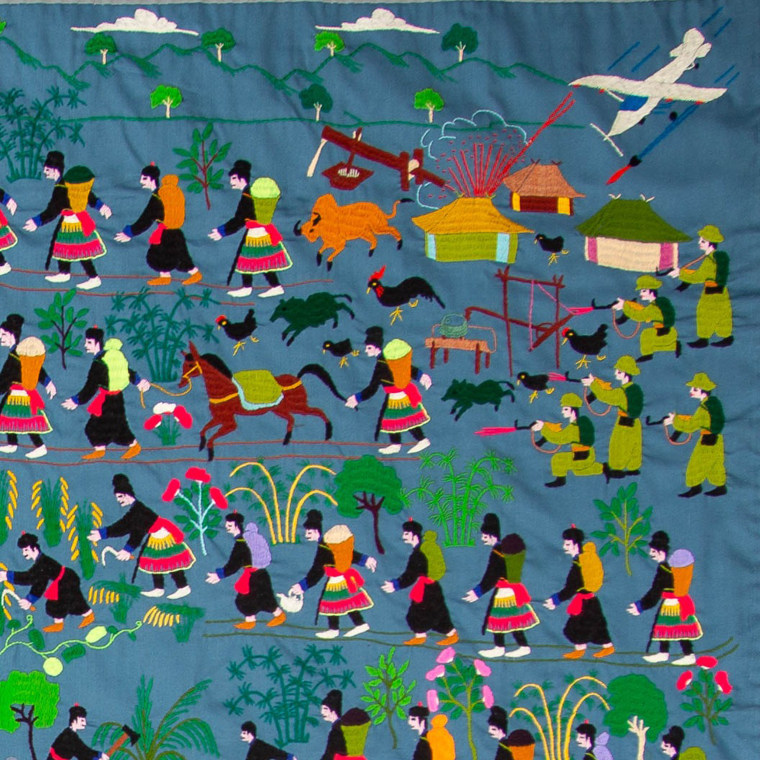
Weaving also had therapeutic value.
As the war concluded, thousands of Hmong families found themselves in refugee camps in neighboring Thailand.
It was there that Hmong women developed a tradition of story cloths: grand embroidered scenes of everyday life and the war that shattered it.
“There are many studies on textile-making and its benefits to mental health,” Pachia Lucy Vang, a Hmong American designer, said by email. “These forms of expression helped people deal with what was on their mind. The longing and loss for homeland.”
Tounekham Koulabdara, who fled southern Laos as a young woman and later settled in the U.S., said weaving was partly an act of Buddhist temperance: an effort to carry on despite the daily chaos of war.
A traditional red skirt, or sinh, that her mother made in the late 1960s — with the red meant to symbolize bloodshed and splitting of families — remains a treasured family heirloom.
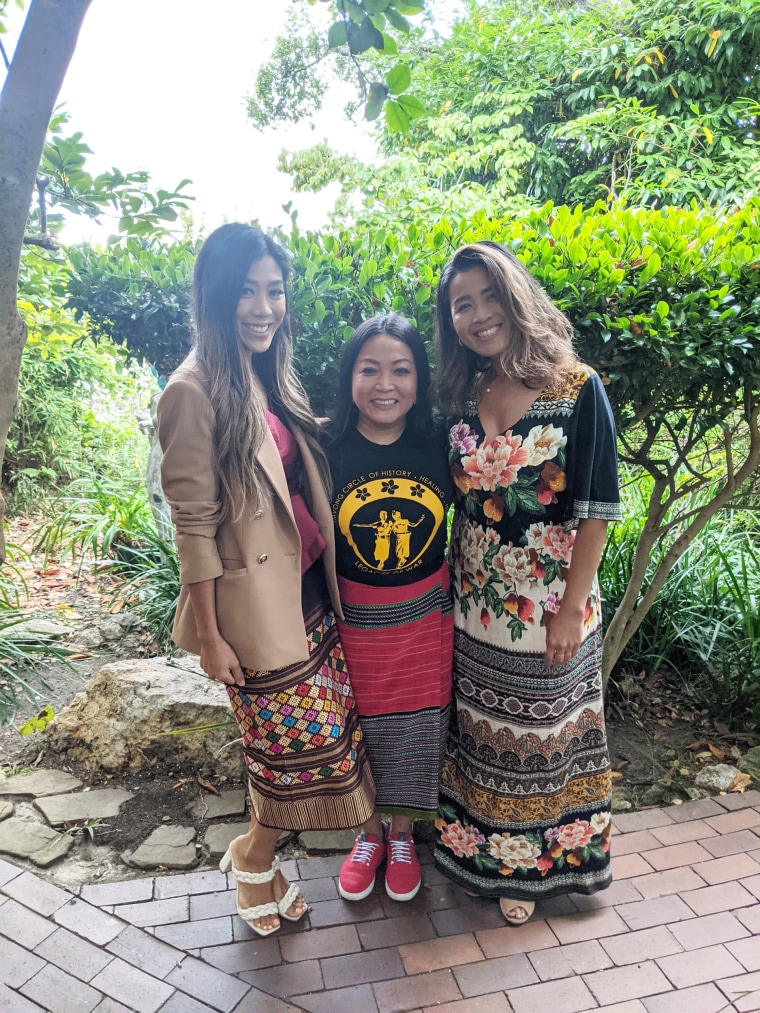
“Many weavers, like my mother, wove what she saw or felt during that time,” said Koulabdara, as translated by her daughter Sera. “Like other artisans, the weaver is allowed to transfer her feelings, lived experience and memories into each thread. I think it’s a way to stitch their stories for the next generation.”
In today’s Laos, weaving is big business. Growing domestic demand for high-grade textiles has drawn women from around the country to weaving workshops.
Today’s chic sinhs, worn for work and weddings, have returned to classic themes of flowers, rivers and elephants.
It’s one reflection of how the Secret War is receding from memory: The war generation is approaching their 70s and 80s, while about half of Laos’ population is under 24.
“For me the war is over,” said a textile merchant in Vientiane. “We should have a more positive view.”
But for some women, weaving remains a quiet, private way to process the past.
Although it’s culturally frowned upon in Laos to speak too pointedly about the war, McIntosh thinks it exerts an invisible effect on survivors and even their descendants.
It did for McIntosh, a Lao American who didn’t understand until later in life why her mother couldn’t bear to speak Lao but was always weaving.
“In a way the seriousness, the gravity, of the war is still expressed in the textile traditions of Laos,” McIntosh said. “This trauma has passed on, but it’s hidden. It’s subliminal. It’s not blatant, but it’s there in Lao society.”
CORRECTION (April 17, 2023, 11:55 a.m. ET): An earlier version of this article misstated a photo credit. The image of one textile is courtesy of Linda McIntosh, not Legacies of War.
CORRECTION (April 18, 2023,, 10:12 a.m. ET): An earlier version of this article misstated that McIntosh's mother was a refugee. She was an immigrant to the U.S., not a refugee.
